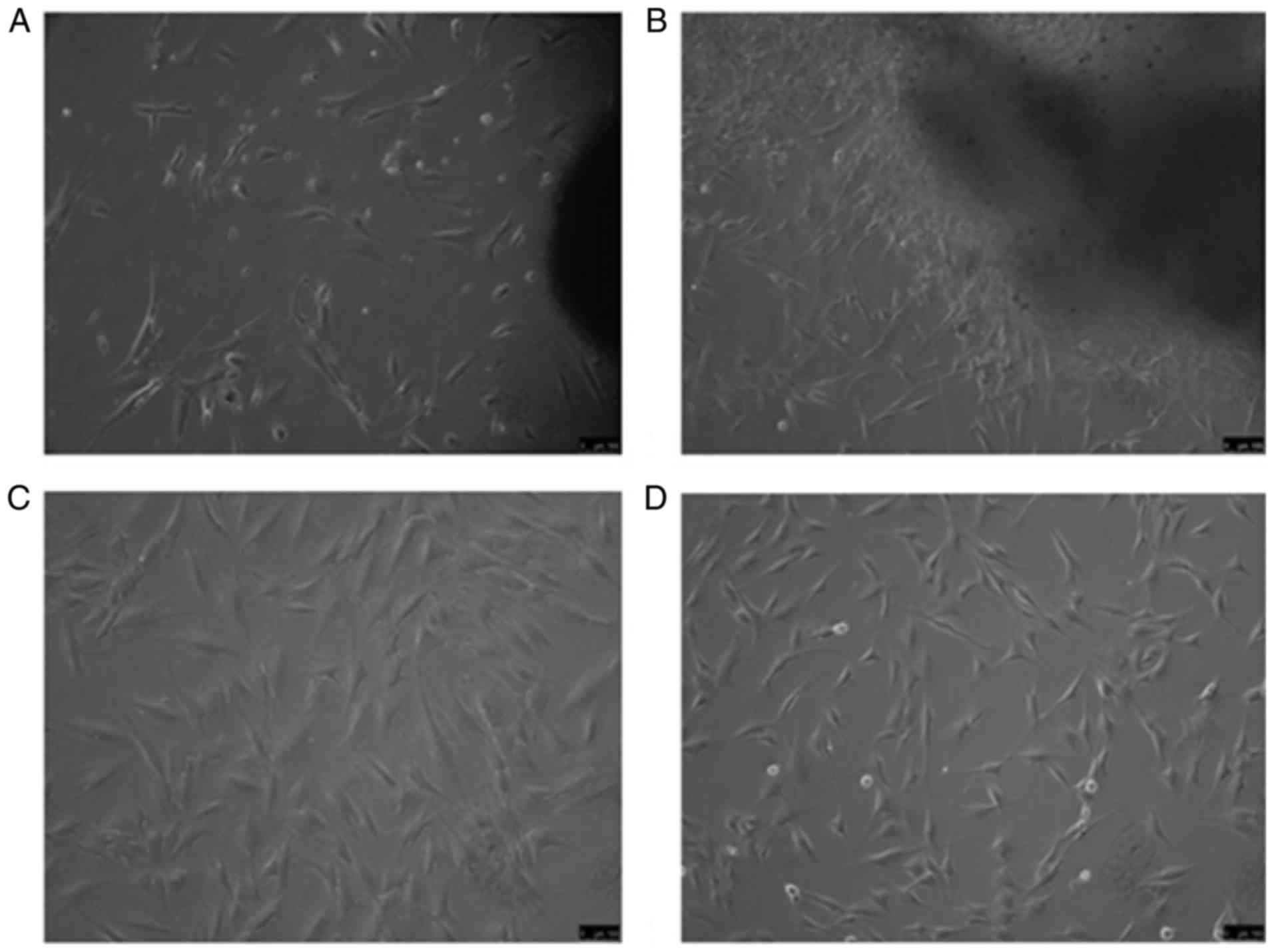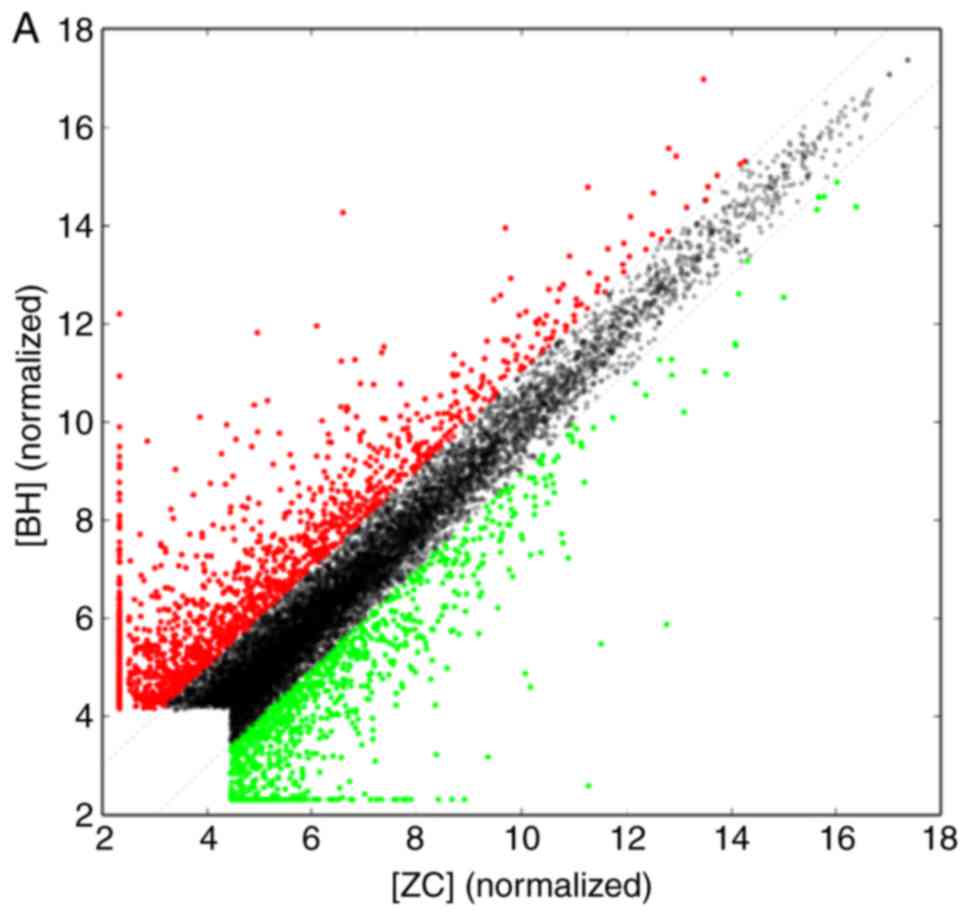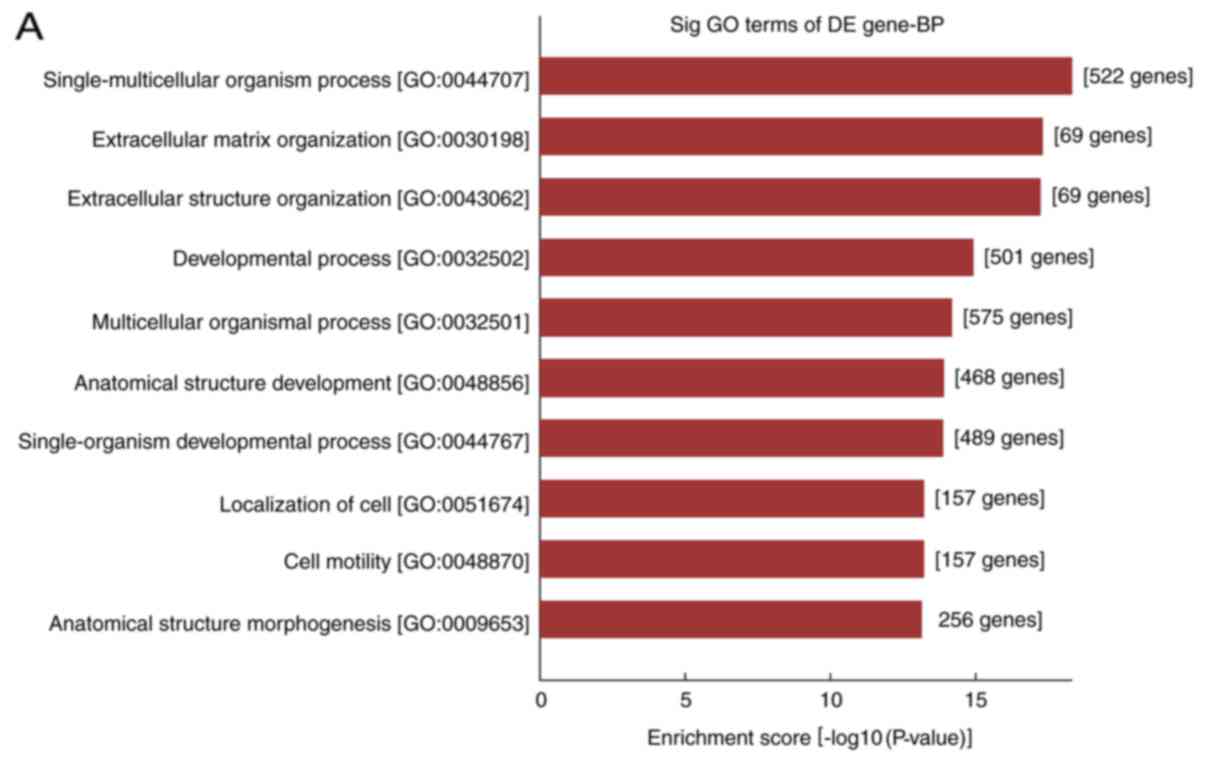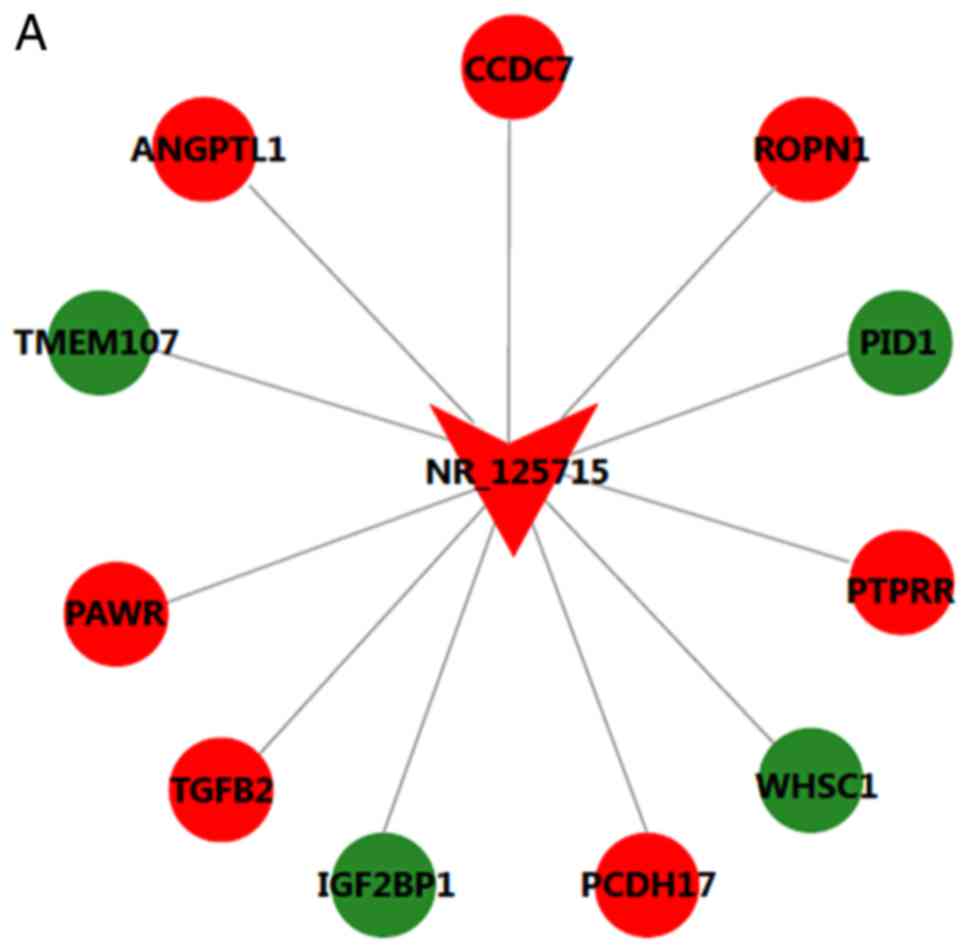|
1
|
Rabello FB, Souza CD and Farina Júnior JA:
Update on hypertrophic scar treatment. Clinics. 69:565–573. 2014.
View Article : Google Scholar : PubMed/NCBI
|
|
2
|
Sorkin M, Cholok D and Levi B: Scar
management of the burned hand. Hand Clin. 33:305–315. 2017.
View Article : Google Scholar : PubMed/NCBI
|
|
3
|
Mokos ZB, Jović A, Grgurević L, Dumić-Čule
I, Kostović K, Čeović R and Marinović B: Current therapeutic
approach to hypertrophic scars. Front Med. 4:832017. View Article : Google Scholar
|
|
4
|
Wan DC and Wang KC: Long noncoding RNA:
Significance and potential in skin biology. Cold Spring Harb
Perspect Med. 4:pii: a0154042014. View Article : Google Scholar
|
|
5
|
Kung JT, Colognori D and Lee JT: Long
noncoding RNAs: Past, present, and future. Genetics. 193:651–669.
2013. View Article : Google Scholar : PubMed/NCBI
|
|
6
|
Engreitz JM, Haines JE, Perez EM, Munson
G, Chen J, Kane M, McDonel PE, Guttman M and Lander ES: Local
regulation of gene expression by lncRNA promoters, transcription
and splicing. Nature. 539:452–455. 2016. View Article : Google Scholar : PubMed/NCBI
|
|
7
|
Lee JT: Epigenetic regulation by long
noncoding RNAs. Science. 338:1435–1439. 2012. View Article : Google Scholar : PubMed/NCBI
|
|
8
|
Gao J, Xu W, Wang J, Wang K and Li P: The
role and molecular mechanism of non-coding RNAs in pathological
cardiac remodeling. Int J Mol Sci. 18:pii: E6082017. View Article : Google Scholar
|
|
9
|
Wang Y, Li Z, Zheng S, Zhou Y, Zhao L, Ye
H, Zhao X, Gao W, Fu Z, Zhou Q, et al: Expression profile of long
non-coding RNAs in pancreatic cancer and their clinical
significance as biomarkers. Oncotarget. 6:35684–35698.
2015.PubMed/NCBI
|
|
10
|
Vassallo I, Zinn P, Lai M, Rajakannu P,
Hamou MF and Hegi ME: WIF1 re-expression in glioblastoma inhibits
migration through attenuation of non-canonical WNT signaling by
downregulating the lncRNA MALAT1. Oncogene. 35:12–21. 2016.
View Article : Google Scholar
|
|
11
|
Pastori C, Kapranov P, Penas C, Peschansky
V, Volmar CH, Sarkaria JN, Bregy A, Komotar R, Laurent G St, Ayad
NG and Wahlestedt C: The bromodomain protein BRD4 controls HOTAIR,
a long noncoding RNA essential for glioblastoma proliferation. Proc
Natl Acad Sci USA. 112:8326–8331. 2015. View Article : Google Scholar : PubMed/NCBI
|
|
12
|
Mineo M, Ricklefs F, Rooj AK, Lyons SM,
Ivanov P, Ansari KI, Nakano I, Chiocca EA, Godlewski J and Bronisz
A: The long non-coding RNA HIF1A-AS2 facilitates the maintenance of
mesenchymal glioblastoma stem-like cells in hypoxic niches. Cell
Rep. 15:2500–2509. 2016. View Article : Google Scholar : PubMed/NCBI
|
|
13
|
Li J, Chen L, Cao C, Yan H, Zhou B, Gao Y,
Li Q and Li J: The long non-coding RNA Lnc RNA8975-1 is upregulated
in hypertrophic scar fibroblasts and controls collagen expression.
Cell Physiol Biochem. 40:326–334. 2016. View Article : Google Scholar
|
|
14
|
Zhou R, Zhang Q, Zhang Y, Fu S and Wang C:
Aberrant miR-21 and miR-200b expression and its pro-fibrotic
potential in hypertrophic scars. Exp Cell Res. 339:360–366. 2015.
View Article : Google Scholar : PubMed/NCBI
|
|
15
|
Li J, Cen B, Chen S and He Y: MicroRNA-29b
inhibits TGF-β1-induced fibrosis via regulation of the TGF-β1/Smad
pathway in primary human endometrial stromal cells. Mol Med Rep.
13:4229–4237. 2016. View Article : Google Scholar : PubMed/NCBI
|
|
16
|
Thomson DW and Dinger ME: Endogenous
microRNA sponges: Evidence and controversy. Nat Rev Genet.
17:272–283. 2016. View Article : Google Scholar : PubMed/NCBI
|
|
17
|
Livak KJ and Schmittgen TD: Analysis of
relative gene expression data using real-time quantitative PCR and
the 2−ΔΔC T method. Methods. 25:402–408.
2001. View Article : Google Scholar
|
|
18
|
Ellwanger DC, Büttner FA, Mewes HW and
Stümpflen V: The sufficient minimal set of miRNA seed types.
Bioinformatics. 27:1346–1350. 2011. View Article : Google Scholar : PubMed/NCBI
|
|
19
|
Agarwal V, Bell GW, Nam JW and Bartel DP:
Predicting effective microRNA target sites in mammalian mRNAs.
Elife. 4:2015. View Article : Google Scholar
|
|
20
|
Zhang J, Li Y, Bai X, Li Y, Shi J and Hu
D: Recent advances in hypertrophic scar. Histol Histopathol.
33:27–39. 2018.
|
|
21
|
Chen L and Li J, Li Q, Yan H, Zhou B, Gao
Y and Li J: Non-coding RNAs: The new insight on hypertrophic scar.
J Cell Biochem. 118:1965–1968. 2017. View Article : Google Scholar : PubMed/NCBI
|
|
22
|
Ponjavic J, Oliver PL, Lunter G and
Ponting CP: Genomic and transcriptional co-localization of
protein-coding and long non-coding RNA pairs in the developing
brain. PLoS Genet. 5:e10006172009. View Article : Google Scholar : PubMed/NCBI
|
|
23
|
Zhu Z, Ding J, Shankowsky HA and Tredget
EE: The molecular mechanism of hypertrophic scar. J Cell Commun
Signal. 7:239–252. 2013. View Article : Google Scholar : PubMed/NCBI
|
|
24
|
Dawes LJ, Elliott RM, Reddan JR, Wormstone
YM and Wormstone IM: Oligonucleotide microarray analysis of human
lens epithelial cells: TGFbeta regulated gene expression. Mol Vis.
13:1181–1197. 2007.PubMed/NCBI
|
|
25
|
Eldred JA, Dawes LJ and Wormstone IM: The
lens as a model for fibrotic disease. Philos Trans R Soc Lond B
Biol Sci. 366:1301–1319. 2011. View Article : Google Scholar : PubMed/NCBI
|
|
26
|
Hahn JM, McFarland KL, Combs KA and Supp
DM: Partial epithelial-mesenchymal transition in keloid scars:
Regulation of keloid keratinocyte gene expression by transforming
growth factor-b1. Burns Trauma. 4:302016. View Article : Google Scholar
|
|
27
|
Sun Q, Guo S, Wang CC, Sun X, Wang D, Xu
N, Jin SF and Li KZ: Cross-talk between TGF-β/Smad pathway and
Wnt/β-catenin pathway in pathological scar formation. Int J Clin
Exp Pathol. 8:7631–7639. 2015.
|
|
28
|
Zhao H, Zhang S, Xu D, Lee MY, Zhang Z,
Lee EY and Darzynkiewicz Z: Expression of the p12 subunit of human
DNA polymerase δ (Pol δ), CDK inhibitor p21WAF1, Cdt1,
cyclin A, PCNA and Ki-67 in relation to DNA replication in
individual cells. Cell Cycle. 13:3529–3540. 2014. View Article : Google Scholar
|
|
29
|
Kang S, Kang MS, Ryu E and Myung K:
Eukaryotic DNA replication: Orchestrated action of multi-subunit
protein complexes. Mutat Res. May 1–2017.Epub ahead of print.
View Article : Google Scholar : PubMed/NCBI
|
|
30
|
Sekelsky J: DNA repair in drosophila:
Mutagens, models, and missing genes. Genetics. 205:471–490. 2017.
View Article : Google Scholar : PubMed/NCBI
|
|
31
|
Zhou Y, Meng X, Zhang S, Lee EY and Lee
MY: Characterization of human DNA polymerase delta and its
subassemblies reconstituted by expression in the MultiBac system.
PLoS One. 7:e391562012. View Article : Google Scholar : PubMed/NCBI
|
|
32
|
Lee MY, Zhang S, Lin SH, Wang X,
Darzynkiewicz Z, Zhang Z and Lee EY: The tail that wags the dog:
p12, the smallest subunit of DNA polymerase δ, is degraded by
ubiquitin ligases in response to DNA damage and during cell cycle
progression. Cell Cycle. 13:23–31. 2014. View Article : Google Scholar
|
|
33
|
Nicolas E, Golemis EA and Arora S: POLD1:
Central mediator of DNA replication and repair, and implication in
cancer and other pathologies. Gene. 590:128–141. 2016. View Article : Google Scholar : PubMed/NCBI
|
|
34
|
Song J, Hong P, Liu C, Zhang Y, Wang J and
Wang P: Human POLD1 modulates cell cycle progression and DNA damage
repair. BMC Biochem. 16:142015. View Article : Google Scholar : PubMed/NCBI
|
|
35
|
Wang Y, Yang T, Zhang Z, Lu M, Zhao W,
Zeng X and Zhang W: Long non-coding RNA TUG1 promotes migration and
invasion by acting as a ceRNA of miR-335-5p in osteosarcoma cells.
Cancer Sci. 108:859–867. 2017. View Article : Google Scholar : PubMed/NCBI
|
|
36
|
Jiang H, Ma R, Zou S, Wang Y, Li Z and Li
W: Reconstruction and analysis of the lncRNA-miRNA-mRNA network
based on competitive endogenous RNA reveal functional lncRNAs in
rheumatoid arthritis. Mol Biosyst. 13:1182–1192. 2017. View Article : Google Scholar : PubMed/NCBI
|
|
37
|
Fabian MR and Sonenberg N: The mechanics
of miRNA-mediated gene silencing: A look under the hood of miRISC.
Nat Struct Mol Biol. 19:586–593. 2012. View Article : Google Scholar : PubMed/NCBI
|
|
38
|
Ul Hussain M: Micro-RNAs (miRNAs): Genomic
organisation, biogenesis and mode of action. Cell Tissue Res.
349:405–413. 2012. View Article : Google Scholar : PubMed/NCBI
|
|
39
|
Bi S, Cao C, Chai LL, Li SR and Yang DY:
Regulatory mechanism of miR-29 over TGF-β1 and COL1 in scar cells.
Eur Rev Med Pharmacol Sci. 21:2512–2517. 2017.PubMed/NCBI
|
|
40
|
Babalola O, Mamalis A, Lev-Tov H and
Jagdeo J: The role of microRNAs in skin fibrosis. Arch Dermatol
Res. 305:763–776. 2013. View Article : Google Scholar : PubMed/NCBI
|
|
41
|
Kurashige J, Mima K, Sawada G, Takahashi
Y, Eguchi H, Sugimachi K, Mori M, Yanagihara K, Yashiro M, Hirakawa
K, et al: Epigenetic modulation and repression of miR-200b by
cancer-associated fibroblasts contribute to cancer invasion and
peritoneal dissemination in gastric cancer. Carcinogenesis.
36:133–141. 2015. View Article : Google Scholar
|
|
42
|
Li P, He QY and Luo CQ: Overexpression of
miR-200b inhibits the cell proliferation and promotes apoptosis of
human hypertro-phic scar fibroblasts in vitro. J Dermatol.
41:903–911. 2014. View Article : Google Scholar : PubMed/NCBI
|
|
43
|
Mu S, Kang B, Zeng W, Sun Y and Yang F:
MicroRNA-143-3p inhibits hyperplastic scar formation by targeting
connective tissue growth factor CTGF/CC N2 via the Akt/mTOR
pathway. Mol Cell Biochem. 416:99–108. 2016. View Article : Google Scholar : PubMed/NCBI
|
|
44
|
Li D, Li X, Wang A, Meisgen F, Pivarcsi A,
Sonkoly E, Ståhle M and Landén X: MicroRNA-31 promotes skin wound
healing by enhancing keratinocyte proliferation and migration. J
Invest Dermatol. 135:1676–1685. 2015. View Article : Google Scholar : PubMed/NCBI
|
|
45
|
Kwan P, Ding J and Tredget EE: MicroRNA
181b regulates decorin production by dermal fibroblasts and may be
a potential therapy for hypertrophic scar. PLoS One.
10:e1230542015. View Article : Google Scholar
|
|
46
|
Rubiś P, Totoń-Żurańska J,
Wiśniowska-Śmialek S, Holcman K, Kołton-Wróż M, Wołkow P, Wypasek
E, Natorska J, Rudnicka-Sosin L, Pawlak A, et al: Relations between
circulating microRNAs (miR-21, miR-26, miR-29, miR-30 and
miR-133a), extracellular matrix fibrosis and serum markers of
fibrosis in dilated cardiomyopathy. Int J Cardiol. 231:201–206.
2017. View Article : Google Scholar
|
|
47
|
Yang QS, Jiang LP, He CY, Tong YN and Liu
YY: Up-regulation of microRNA-133a inhibits the MEK/ERK signaling
pathway to promote cell apoptosis and enhance radio-sensitivity by
targeting EGFR in esophageal cancer in vivo and in vitro. J Cell
Biochem. 118:2625–2634. 2017. View Article : Google Scholar
|













